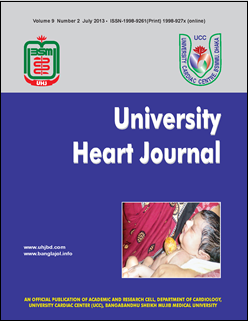Outcomes of primary percutaneous coronary intervention (PCI) in NICVD, Dhaka,Bangladesh- our initial experiences
DOI:
https://doi.org/10.3329/uhj.v9i2.23428Keywords:
Primary PCI, STEMIAbstract
The aim of the study is to determine the out comes of primary percutaneous coronary intervention (PCI) in patients with acute myocardial infarction in NICVD the only government cardiac hospital of Bangladesh where resources are very limited. Total 73 (male 70, female 3) patients were enrolled in this study who were brought in to our hospital with STEMI between August 2010 to October 2013. Average age was 55.6 ±11.78. Primary PCI was performed after transferring patient from Emergency Department to cardiac catheterization laboratory. Cardiovascular risk factors among the studied population were Diabetes mellitus, Hypertension, Smoking, Dyslipidemia and Positive family history for IHD. Primary PCI either with Bare Metal Stent (BMS) or Drug Eluting Stent (DES) were performed in total 42 LAD lesions, 28 RCA lesions and 3 LCX lesions. BMS used were 87.7%, DES used were 12.3%. The procedural success was 95.8%.Four patients (5.4%) died during hospital stay. Out of four patients who died, one had cardiogenic shock. No mortality was observed in the 30 days follow up from discharge, while other complications like unstable angina and congestive heart failure were 5.7% and 4.3% respectively. Our findings suggest favorable outcomes, matching the international data which was achieved in our patients with primary PCI in the management of STEMI despite all the limitations. Primary PCI as a preferred method of reperfusion strategy needs to be practiced more often in our part of world.
University Heart Journal Vol. 9, No. 2, July 2013; 83-87
Downloads
370
396

